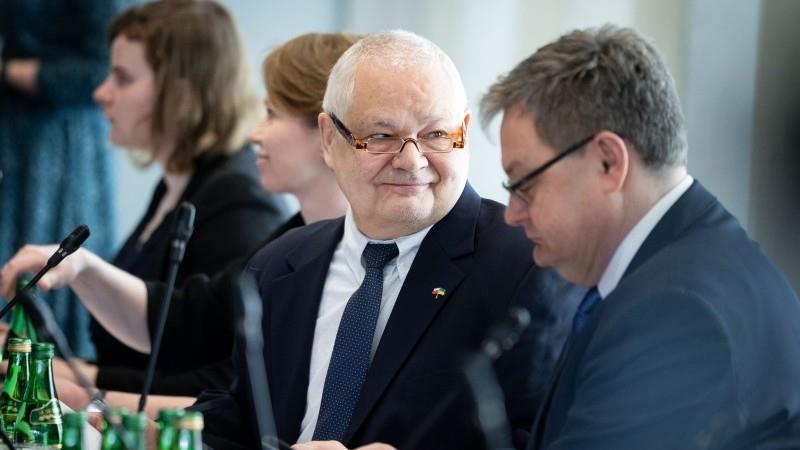
NBP Governor Leaves All Options Open As He Explains Latest Rate Cut Reasoning
We've been hearing from the Governor of the National Bank of Poland, Adam Glapinski, explaining the reasons for lowering the country's interest rate again by 25bp to 4.25%. It was the fifth rate cut this year.
Firstly, he points out that, according to preliminary data from the Central Statistical Office (GUS), CPI inflation in October fell to 2.8% year-on-year and is close to the central bank's 2.5% inflation target, which he described as a great success.
Secondly, Glapiński noted that initial estimates indicate that core inflation has also declined.
Thirdly, he stated that the medium-term inflation outlook has improved, with inflation projections in line with the 2.5% target with +/-1pp tolerance band over the next two years.
Regarding medium-term prospects, Adam Glapiński referred to the NBP staff's November projection, which assumes a lower level of inflation in Q4 2025 and in 2026 than previously expected, despite a marked decrease in interest rates since the July projection. Over the projection horizon, inflation is expected to be broadly consistent with the target. The Governor emphasised that in 2025, the MPC has already cut rates by 150 basis points, which supports economic growth and reduces the costs of public debt service (by PLN 20 billion over two years) and mortgage payments.
Robust economic growth in PolandIn Adam Glapiński's assessment, the economy is growing at a solid pace, supported by NBP rate cuts, as evidenced by the rebound in lending activity across every market segment. Data for September was positive, with strong growth in industrial production and retail sales, and positive growth in construction, too. He's expecting a revival of investments, which will ease inflationary pressure. However, the extent to which the EU's RRF funds are to be utilised remains subject to significant uncertainty.
Inflation risksAs in previous statements, Adam Glapiński listed the inflation risks, including
elevated service inflation, uncertainty regarding energy prices (including an increase in the capacity fee from 2026), and an excessive general government deficit and rapidly rising public debt.In the medium term, the risk remains the introduction of the ETS2 system, which would impose permits on carbon dioxide emissions from transport and buildings, raising fuel and heating costs for households.
While the ETS2 continues to pose an upside risk to the inflation outlook, it is not incorporated into the baseline scenario, particularly following the recent agreement by EU environment and climate ministers to delay its implementation until 2028, which lies beyond the current projection horizon.
A noteworthy change is that the central bank governor no longer lists rapid wage growth as an inflation risk. Moreover, Professor Glapiński noted that it's actually slowing, and employment in the enterprise sector is falling.
Monetary policy and its outlookGlapiński reiterated that further MPC decisions will be data-dependent and made meeting by meeting. He declared a cautious approach to monetary policy and actions aimed at maintaining low inflation. He expressed the view that the current level of interest rates is limiting inflation while at the same time supporting economic growth. According to the NBP, we are currently close to an ideal state, and future rate decisions are a matter of fine-tuning. He repeated his view that the target rate lies within the 3.5%-4% range.
SummaryThe conference did not deliver any clear signals regarding the Council's next steps. On the one hand, the fact that Governor Glapiński emphasised the scale of significant monetary easing to date (totalling 150bp), the dynamism of the Polish economy and the need to maintain low inflation suggest a reduced inclination towards further rate cuts in the near term. Similarly, the assertion that the current rate level is appropriate for the situation can be interpreted in the same way.
The Governor also noted that the NBP is monitoring the impact of previous decisions on the economy, which will take time. Inflation could reach the NBP's target or even fall below it later in November, which may prompt the Council to cut rates again, especially as Glapiński did not rule out the possibility of changes to interest rates in December. He mentioned that in the past, significant changes to monetary policy parameters were made in December. The Governor also reiterated that the target rate lies between 3.5%-4%.
Our baseline scenario assumes the next rate cut will not occur until March and that the reference rate will be reduced to 3.5% by mid-next year. The window for rate changes is more likely to be in the first half of 2026, as in subsequent quarters the economic situation is expected to improve, and the credit cycle will gain momentum.
With the Council's reaction function unclear, anything can happen in December. Today's statement suggests that the probabilities of the NBP cutting rates and leaving them unchanged are roughly equal. A favourable current inflation reading, which we will learn at the end of the month, and inflation falling to the 2.5% target or even below, may prompt the Council to undertake another“adjustment”.

Legal Disclaimer:
MENAFN provides the
information “as is” without warranty of any kind. We do not accept
any responsibility or liability for the accuracy, content, images,
videos, licenses, completeness, legality, or reliability of the information
contained in this article. If you have any complaints or copyright
issues related to this article, kindly contact the provider above.


















Comments
No comment